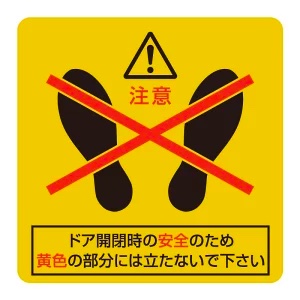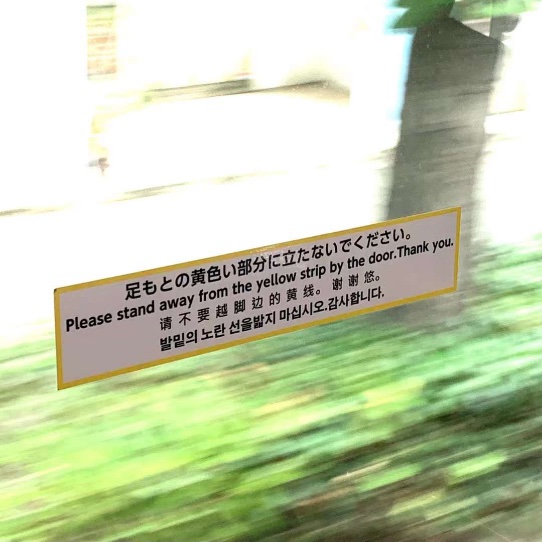Orthographic-crosslingual pun
« previous post | next post »
Xiaowan Cai received this picture from a friend of hers who is on exchange from Oxford University at Kyoto University. Everything in all four languages on the sign looks pretty normal, except that there is a not easily detectable, extraordinary gaffe — or ingenious tour de force — in the Chinese.
I will go through the languages one by one in the order they appear on the sign.
Japanese
Ashimoto no kiiroi bubun ni tatanaide kudasai.
足もとの黄色い部分に立たないでください。
(Lit.) Please don't stand on the yellow part (area / section) under / at your feet.
The expression one is used to seeing (or hearing) at a train station is something like this:
Kiiroi sen no uchigawa de omachi kudasai
黄色い線の内側でお待ちください。
Please wait behind (lit., inside) the yellow line.
Nathan Hopson adds:
The "section" (bubun 部分) is maybe ambiguous enough to cause translation errors, but the Japanese is boilerplate.
You can hear an announcement like this here:
Doa ga shimarimasu. Kiiroi yuka bubun ni tatanaide kudasai.
ドアが閉まります。黄色い床部分に立たないでください。
"The doors are closing. Please do not stand on the yellow floor section."
or see an example of a sign saying more or less the same thing here:

English
As one can see by comparison with the Japanese, Chinese, and Korean, the English on the sign actually takes considerable liberties in order to sound idiomatic and get the desired message across. To my ear, it would be even more natural if it replaced "away" with "back".
Chinese
Qǐng bùyào yuè jiǎo biān de huáng xiàn. Xièxiè yōu.
请不要越脚边的黄线。谢谢悠。
"Please do not cross the yellow line at your feet. Thank you."
The amazing blunder or clever crosslinguistic pun — it might be either; depends whether it's intentional or not — is the use of yōu 悠 ("remote; distant; leisurely; to swing") for nín 您 ("you" [honorific]).
Korean
Balmitui noran soneul bapjji masipssio. Gamsahamnida. (revised romanization)
발밑의 노란 선을밟지 마십시오.감사합니다
"Do not step on the yellow line under your feet. Thank you."
The grammar is correct, but there are two spacing errors:
발밑의 노란 선을 V밟지 마십시오. V감사합니다.
According to a quick Google search, the following sentence is used at subway/train stations:
noran soneso han goreum mulroso jusigi baramnida. Gomapsseumnida
노란 선에서 한 걸음 물러서 주시기 바랍니다. (고맙습니다.)
Please take a step back from the yellow line. (Thank you.)
Selected readings
- "Mind the gap" (9/1/15)
- "Wait until leader clears the lunar" (4/21/22)
- "University City train station notes" (11/2/19)
[Thanks to Haewon Cho and Hiroko Sherry.]

Jerry Packard said,
June 26, 2022 @ 12:23 pm
The Chinese version is most likely a typo – 悠 for 您 as Victor notes – rather than a pun. I can imagine it being produced by a handwriting-to-print conversion program because they are so visually similar. A Google search on "谢谢悠" returns 21,700 hits, but they are mostly cases in which '悠' is part of a person's name or something similar.